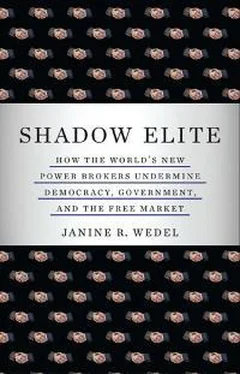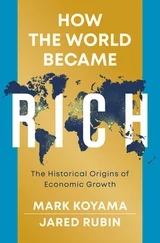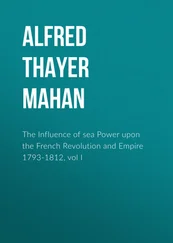The economist quoted is James R. Millar, “From Utopian Socialism to Utopian Capitalism: The Failure of Revolution and Reform in Post-Soviet Russia,” Washington, DC: George Washington University 175th Anniversary Papers, paper 2, 1996, p. 8.
With regard to Chubais’s scheme offering “fertile ground for criminal activity,” see Nelson and Kuzes, Radical Reform in Yeltsin’s Russia , p. 51.
With respect to loans for shares: Loans for shares also helped bankrupt the state, leaving it unable to fund many social services, which, of course, alienated the population. Boris Fyodorov, a former finance minister, characterized loans for shares as “a disgusting exercise of a crony capitalism, where normal investors were not invited, where even among Russian so-called investors, only those who were friends of certain people in the government were invited. And there’s a big suspicion that no real cash came to the government. . . . These loans for shares unleashed a wave of corruption like never before.” Frontline , “Return of the Czar,” interview with Boris Fyodorov, PBS, http://www.pbs.org/wgbh/pages/frontline/shows/yeltsin/interviews/fyodorov.html.
21. The Merry quote is from interview with E. Wayne Merry, “Return of the Czar,” Frontline .
22. For analysis of the voucher privatization program and its impact, see Hilary Appel, “Voucher Privatisation in Russia,” and Nelson and Kuzes, Property to the People , pp. 25–56.
23. With regard to privatization and the popularity of politicians, see Janet Gultsman, “Yeltsin Says Still Pro-Reform, Scathing on Chubais,” Reuters Financial Service , January 19, 1996. Hilary Appel adds that Yeltsin provided details such as the following: He said that, while the mayor of Moscow managed to create 6,000 billion rubles in revenue in the Russian capital, Chubais managed to create only 8,000 billion rubles from throughout the country (ITAR-TASS World Service, February 16, 1996, cited in “Russia: Yeltsin Notes Main Tasks of Privatization,” FBIS-SOV-96.33 , February 16, 1996). See Appel, “Voucher Privatisation in Russia.”
24. The Economist article is “A Survey of Russia’s Emerging Market: A Silent Revolution,” April 8, 1995.
25. With regard to Harvard players obstructing reform efforts that originated from outside their approved circle: When Stanford University was awarded a contract to work with the Chubais Clan-run Federal Securities Commission, Vasiliev turned down Stanford’s help. When I asked Shleifer for an explanation, he said that Vasiliev “had a group of people he was working with,” meaning, of course, the Harvard players (author’s interview with Andrei Shleifer, September 5, 1996). Later, the clan secured additional funds out of USAID for the same project that Stanford was to have worked on, now with Harvard as a partner. (In September 1995, the Russian Federal Commission and the Harvard Institute received $1.7 million as an amendment to the 1992 cooperative agreement.) GAO sources confirmed that the Harvard-Chubais players obstructed reform efforts that originated from outside their approved circle (conversations of October 28, 1997, and April 23, 1998, with Louis H. Zanardi, who spearheaded the GAO’s investigation of the Harvard Institute’s activities in Russia and Ukraine). One example of this involves interference by the Russian Privatization Center with efforts by the U.S.-funded Senior Executive Service Corps. With respect to Harvard players blocking legal reform efforts, information was gleaned through interviews with USAID-paid contractors and U.S. government sources. A member of the GAO audit team confirmed this observation (conversations of October 28, 1997, and April 23, 1998 with Louis H. Zanardi). Quote of GAO lead investigator is from author’s interview with Louis Zanardi, January 25, 2001.
26. See U.S. General Accounting Office, Foreign Assistance: Harvard Institute for International Development’s Work in Russia and Ukraine (Washington, DC: GAO, November 1996), p. 8. USAID contracts to design and implement CSOs totaled $13.9 million. For additional details, see also Janine R. Wedel, “Clique-Run Organizations and U.S. Economic Aid: An Institutional Analysis,” Demokratizatsiya: The Journal of Post-Soviet Democratization , no. 4 (Fall 1996), pp. 592–593.
27. The players do not deny making these investments. For details, see United States District Court, District of Massachusetts, United States of America, Plaintiff, v. The President and Fellows of Harvard College, Andrei Shleifer, Jonathan Hay, Nancy Zimmerman, and Elizabeth Hebert, Defendants , Civil Action No. OOCV11977DPW, September 26, 2000, p. 30; and, for example, Thanassis Cambanis, “US Seeking $102M from Harvard, Pair,” Boston Globe , June 27, 2002. Lawyers for Harvard, Shleifer, and Hay argued that the investments of project staff (Shleifer and Hay) neither affected Harvard’s work in Russia (see, for example, Thanassis Cambanis, “Prosecutors Argue Harvard Owes US at Least $34M in Russia Case,” Boston Globe , December 18, 2002) nor violated the university’s agreements with the U.S. government (see, for example, Thanassis Cambanis, “US Seeking $102M From Harvard, Pair”).
28. United States District Court, District of Massachusetts, United States of America, Plaintiff, v. The President and Fellows of Harvard College, Andrei Shleifer, Jonathan Hay, Nancy Zimmerman, and Elizabeth Hebert, Defendants .
29. The suit, registered by Forum Financial Group of Portland, Maine, states that Hay and Shleifer used their pull with Russian officials to acquire for the company the rights to the country’s first mutual fund. They then compelled its owner to sell his interest in the fund. For information about the settlement of the case, see, for example, David H. Gellis, “Harvard in Settlement Talks with Forum,” The Harvard Crimson , 30 October 2002; and “Harvard Settles With Mutual Funds Company Over Fraud Allegations,” Associated Press, November 8, 2002.
30. The Cohen quote is from Stephen F. Cohen, Failed Crusade: America and the Tragedy of Post-Communist Russia (New York: W. W. Norton & Company, Inc., 2001), p. 13. Also see Cohen ( Failed Crusade ) for analysis of American media coverage of Russian “reforms.”
With regard to Shleifer and Vishny as business partners: In 1994, Shleifer, Vishny, and Josef Lakonishok, all experts in behavioral finance, started LSV Asset Management, a money management company based in Chicago (David McClintick, “How Harvard Lost Russia,” Institutional Investor Magazine Online , January 13, 2006, p. 30, http://jboy.chaosnet.org/misc/docs/articles/shleifer.pdf). For Vishny’s work with the Chubais-Harvard team, see, for instance, Boycko, Shleifer, and Vishny, Privatizing Russia , p. vii.
The Harvard Institute supported the writing of Boycko, Shleifer, and Vishny’s Privatizing Russia , according to the authors. The New Republic reports that this support was provided by USAID through the Harvard Institute (Stephen Kotkin, “Stealing the State,” April 13, 1998, p. 30). However, I was unable to confirm direct USAID support for the project. The claim that a “large class of owners” was created is found in Boycko, Shleifer, and Vishny, Privatizing Russia , p. vii.
31. The Donald Pressley quote is from an interview with him aired on Monitor Radio, May 22, 1997. The U.S. investigator cited here is Phil Rodokanakis, former senior agent in USAID’s Office of the Inspector General (author’s interview of January 25, 2001).
32. Sources on Åslund’s role in Swedish policy and aid include Dan Josefsson, “The Art of Ruining a Country with Some Professional Help from Sweden,” ETC , English Edition 1, 1999. U.S. officials in the Departments of Treasury and State supplied information (via interviews) about Åslund’s participation in meetings in these agencies. On Åslund’s business activities, he was, for example, linked to Brunswick, which began as a Moscow-based brokerage firm and evolved into an investment bank, the Brunswick Group (Anne Williamson, Contagion , Chapter 13, unpublished manuscript; Williamson writes on economics and Soviet and Russian affairs). Two of Åslund’s Swedish associates worked for Chubais at the State Property Committee, where they helped to design and implement voucher privatization (Williamson’s interview with Martin Andersson, February 1995). Later, “with still good relations to Chubais,” they started Brunswick Brokerage to participate in voucher privatization and to help sell these and other assets to Western investors. (Sven-Ivan Sundqvist, “Svenska Rad Biter Pa Ryssen: Svenska Finansman i Ledningen for Brunswick Group, Foretaget Som Ska Hjalpa Ryska Staten Att Privatisera Industrin,” Dagens Nybeter , June 15, 1997.) While Åslund claims that he only gives “lectures and briefings” (“Tainted Transactions: An Exchange,” The National Interest , no. 60 [Summer 2000], p. 101), he attended an April 1997 banking conference in New York sponsored by Brunswick Securities Ltd. as a representative of Brunswick . He promoted the Russian stock market to institutional investors and money managers, according to Michael Hudson, who also participated in the conference. (Anne Williamson communication with Michael Hudson of May 16, 1999; and Wedel interview with Hudson, September 8, 1999.) Hudson adds (April 3, 2000) that the minimum acceptable investment was between $400,000 and $500,000. Åslund’s current wife, Anna Viktorovna Åslund, Gaidar’s former press secretary, has listed an affiliation with Brunswick-Warburg. (Brunswick entered into an association with Warburg, effective November 1997.)
Читать дальше












